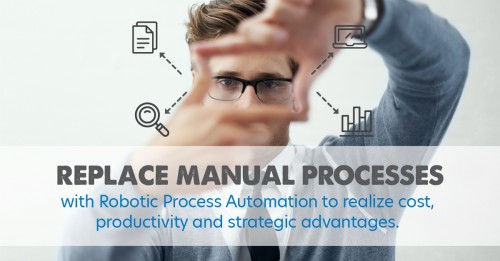Stop Your Swiveling: How Robotic Process Automation Improves Insurers
Blog: Kofax - Smart Process automation
Meet Cole. Cole works at a large P&C insurance company in the motor vehicle insurance underwriting department. Cole is responsible for accessing and compiling DMV records and CLUE reports for underwriters to evaluate for new policyholders. This job requires logging into the specific state(s) Department of Motor Vehicles website/data, and service providers like LexisNexis, to input information about each insurance applicant into their system, request reports, and log back out. Then Cole inputs the information into his company’s core systems for underwriters to review.
A typical employee doing Cole’s job can manually process applications for approximately 8 hours per day, swiveling his/her chair to work between internal and external systems, portals websites and applications. Cole is the departmental star: he can process applications 24 hours per day, 7 days per week without taking breaks or needing to sleep.
What makes Cole so productive?
He’s a robot.
Cole isn’t a physical robot like R2-D2 or Optimus Prime, but a software robot that uses intelligent business rules to mimic the actions your employees take while performing tasks within applications.
Are robots taking over the world?
Not really. But robotic process automation is. Deloitte puts it this way:
“Robot-led automation has the potential to transform today’s workplace as dramatically as the machines of the Industrial Revolution changed the factory floor.”
Put simply, robotic process automation (RPA) is a tool for your insurance organization to automate repeatable, predictable tasks, without a fundamental process redesign or a complete systems overhaul.
RPA is sending Cole to grab data that’s a fundamental part of your underwriting process, and freeing up Cole’s human coworkers to focus on higher value activities or spend more time providing excellent customer service instead of collecting and entering data that any, well, robot could do.
RPA is taking the “X” factor out of offshoring or outsourcing (one company estimated that RPA saves 50 to 70 percent on labor costs).
It’s hedging your bets against process errors and non-compliance by automating tasks that are prone to manual errors and recording those tasks for process improvement and an audit trail.
Finally, RPA is a scalable way for your insurance organization to decrease cycle time and throughput, and realize incredible cost and efficiency improvements.
The use cases for RPA in Property & Casualty and Life insurance are practically endless. Check out examples from actuary to underwriting to claims in our new eBook on RPA for insurers.
Will robots steal our jobs?
A common misconception about robotic process automation is that it will eliminate the human element. It’s true that robots are faster than humans at many of these rote, manual tasks. While Cole is gathering underwriting data, his robot buddies are extracting structured data from PDFs, merging data from multiple sources, and reading and writing to multiple system databases.
Join us at Inspire 2017 for the latest trends on how RPA is transforming workplace productivity.
Deloitte notes that relieving employees of these rote, mundane tasks actually improves employee morale and customer service. Cole the robot may have taken over the job of Sue the human, but Sue got a promotion. Rather than gather and input data, she works on more difficult cases that require the human touch. Sue gets to use her brain and make strategic decisions, which gives her a greater sense of value and drive to perform in her job.
In essence, Cole works side-by-side with your employees to create a digital workforce that streamlines operations and expedites key business activities.
Robots in the real world
A large finance and insurance provider needed to reduce delays in their processes. In addition to multiple redundant steps, many of their workflows required extensive manual intervention. By deploying a “Cole”, a robot automatically pulls 86 data points into a centralized document. The net result? The provider now adjudicates claims 75% faster.
Another insurer wanted to improve efficiencies when running reports. It took 3 people 2 hours each to generate 300 reports in PDF format. When robotic process automation was applied, one robot ran for 14 hours straight, generating more than 7000 reports in PDF format.
Break through human barriers with robotic process automation
With robotic process automation, your insurance organization is poised to gain an enormous competitive advantage. Lower processing costs, fewer errors, and a higher level of customer service are just a few of the benefits of implementing RPA.
Learn how your insurance organization can eliminate manual processing without disrupting the internal systems and processes you’ve invested in. Download “Stop Your Swiveling: Robotic Process Automation for Property & Casualty and Life Insurers” today.
Leave a Comment
You must be logged in to post a comment.







